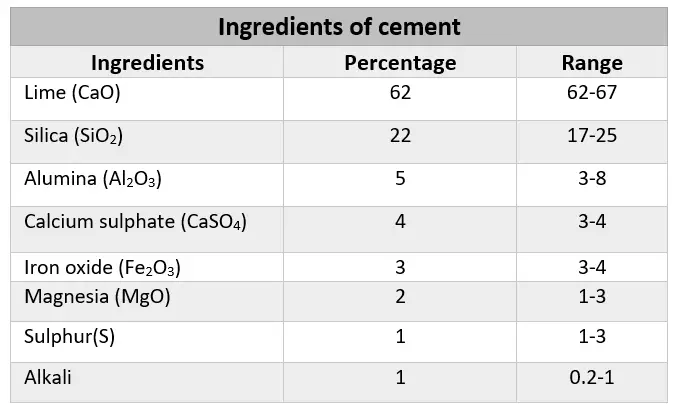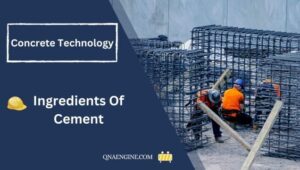In this comprehensive guide on the ingredients of cement, we will discuss in detail the ingredients of cement. chemical composition of cement, the formula of cement, and its functions, and how any variation in the proportion of these ingredients of cement affects the properties of cement.
What is Cement?
Cement is an important ingredient of concrete, which acts as binding material having cohesive and adhesive properties. Natural cement is obtained by burning and crushing stones containing a certain amount of clay, lime carbonate, and magnesium carbonate.
Cement is an artificial material that is obtained or manufactured by burning at a very high temperature (1400°c -1450°c), a mixture of calcareous material (containing lime), argillaceous material (containing alumina), and siliceous material (containing silica) in a proper proportion. The product obtained on burning is known as the clinker. A small quantity of gypsum is added to the clinker and then it is pulverized into the required fineness, which is known as cement.
Raw materials of Cement
Portland cement consists necessarily of compounds of lime (calcium oxide) mixed with silica (silicon diaoxide) and alumina( aluminum oxide). The lime is acquired from the calcareous raw materials. The oxides are derived from an argillaceous (clayey ) material. Additional raw materials such as silica sand, iron oxide, and bauxite-containing hydrated aluminum, Aluminium hydroxide may be used in smaller quantities to get the desired composition.
The most common calcareous ingredients of cement are limestone and chalk, but others such as shell deposits, also are used. Shale, slate, clays, and estuarine mud are the common argillaceous raw materials.
Kaoline which is a white clay that contains little amount of iron oxide is used as an argillaceous compound for white portland cement.
Industrial wastes, such as calcium carbonate and fly ash from chemical manufacturers are one of the possible sources of raw materials.
Blast-furnace slag contains mainly lime, silica, and alumina which is also another source of raw material.
Marl, which is a cement rock that contains both the calcareous and argillaceous components in proportions, is another source of raw materials of cement.
Gypsum is another cement component added to the burned cement clinker during grinding to control the cement setting time.
Ingredients of Cement:
There are eight basic ingredients of cement. The ingredients of cement are as follows
- Lime
- Silica
- Alumina
- Calcium sulfate
- Iron Oxide
- Magnesia
- Sulfur
- Alkalies

Functions of cement ingredients:
- Lime- The right proportion makes the cement strong and sound.
The excess amount of lime in cement makes the cement unsound and causes unnecessary expansion and disintegration.
The deficiency in the amount of lime decreases the strength and causes the cement to set very quickly. - Silica-It imparts strength to the cement due to the formation of dicalcium silicate and tri-calcium silicate.
The excess amount of the silica content as cement ingredients provides greater strength but prolongs the setting time. - Alumina- Alumina gives quick setting quality to the cement. It acts like a flux that lowers the temperature of the clinker.
The excess amount of alumina as cement ingredients reduces the strength of the cement.
Iron Oxide
It provides strength, color, and hardness to the cement.
Calcium sulfate or Gypsum
The presence of a small amount of gypsum is essential as it delays the initial setting time of cement. - Magnesia- The presence of a small amount of magnesia imparts hardness and color.
The excess amount of magnesia as cement ingredients makes the cement unsound. - Sulphur- The presence of a small amount of sulfur is useful but the excess amount of it makes the cement unsound.
- Alkalies- The excess amount of alkalies causes efflorescence, alkali-aggregate reaction, and staining when used in brickwork and concrete work.
FAQ-Ingredients of Cement:
What are the main Ingredients of cement with the percentage?
The ingredients of cement and their percentage composition can vary depending on the specific type of cement being produced. Typically are the following ingredients and approximate percentage composition:
Calcium oxide (CaO) or Lime – 63%
Silica (SiO2) – 22%
Alumina (Al2O3) – 6%
Iron oxide (Fe2O3) – 3%
Magnesia (MgO) – 2%
Sulfur trioxide (SO3) – 2%
Alkalis (Na2O and K2O) – 1%
Other minor components – 1%
What are the steps involved in the manufacturing of cement?
The production of cement includes the following process:
- Mining and grinding: At first, the main raw materials for cement (limestone, clay, sand, iron ore, and gypsum)are mined and then ground into a fine powder.
- Mixing and preheating: The ground raw materials are mixed together and then heated in a preheater or pre-calciner to drive off any moisture and prepare them for the kiln.
- Burning and cooling: The preheated raw materials are fed into a rotary kiln. They are heated to extremely high temperatures (over 1400°C) to form clinker. The clinker is then cooled rapidly in a cooler to prevent it from re-forming back into raw materials.
- Grinding and storage: The cooled clinker is then ground into a fine powder with the addition of gypsum to regulate the setting time. This is usually done in a ball mill.
- Packaging and transportation: The finished cement powder is stored in silos and then packed into bags or bulk trucks for transportation to construction sites.
Why is gypsum added to cement?
To control the “setting of cement,” gypsum is used.
The cement will set immediately after the water and cement have been mixed, leaving no time for pouring the concrete.
OPC or PPC—which is better?
In performance compared to OPC, PPC has a lower heat of hydration and is less likely to break. Although PPC is less strong than OPC, it offers greater workability and finishing. More chemical resistance is offered by PPC.
Why is fly ash used in cement?
The use of fly ash in concrete enhances both the strength and durability of hardened concrete as well as the workability of plastic concrete. Fly ash use is also cost effective. When fly ash is added to concrete, the amount of Portland cement may be reduced.
Which type of cement is used on teeth?
There are still zinc phosphate, zinc oxide eugenol, and polycarboxylate cements used in dentistry. However, because of their better qualities and handling features, glass ionomer and resin composite cements are the most often utilized presently.

